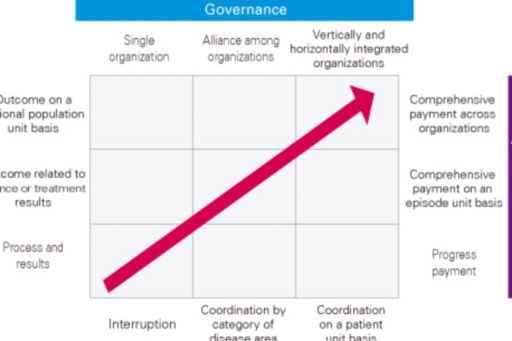Close-up 2: Transformation to 21st century health care: Four key trends
Transformation to 21st century health care
All advanced economies now face the three challenges of aging, fiscal restraints, and a dwindling workforce. In 2025, Japan’s baby boomers will be over 75 years old. By 2035, their children will be over 65 years old.
While the need for medical and nursery care further expands in the coming years, declining birth rate will drastically worsen fiscal conditions and workforce shortages will deepen. Fundamental healthcare reforms will be the only viable course to solve the crisis that Japan is expected to face in the next twenty years. This article explores how the crisis can be turned into an opportunity by discussing the possible direction of healthcare reform from the perspectives of four significant trends.
[Trend ONE] Patient engagement: Enhanced involvement of patients and consumers
The latest survey on patients compiled by the Ministry of Health, Labor and Welfare reveals that as many as half of all patients were treated for one or more of the three lifestyle diseases: diabetes, hyperlipidemia, and high blood pressure. Most patients with these diseases are elderly and are diagnosed and treated by doctors face to face. Against this backdrop, online medical treatment has been added for the first time to Japan’s national health insurance treatment scheme in April 2018. The scheme is still in its early development stages with a limited number of users, held back by the rigor of requirements for insurance coverage. The scheme, however, has represented a breakthrough in making virtual medical treatment available domestically. In many developed countries, virtual treatment has already been in a penetration phase with help from strong advocacy efforts. Kaiser Permanente, the largest healthcare system in the US, for example, reports that 50% or more of the medical treatments extended to over 100 million patients have been provided on a virtual basis.
Globally, it is now recognized that the proactive involvement of patients and consumers in their own treatment is significantly effective in lowering medical expenses. Online medical treatment reduces the cost of managing diseases while improving convenience for patients, helping wider involvement. Many diagnostic technologies will be available at home in near future with the development of new wearable devices and sensing technologies as well as the introduction of the 5G, new high-speed communication system.
Insurance companies too have been offering incentives for the insured to promote their own health as part of their efforts to encourage patients to take part proactively in their own health management. Discovery, a South African insurance company, offers discounts in insurance premiums, depending on a level of patient’s involvement in various health programs and the achieved outcomes. Discovery, partnering with various companies, provides the insured with health-promoting gadgets such as Fitbits and Apple Watches as well as fitness services. On the bottom line, the company has succeeded in reducing its insurance benefit payouts and expanded its profits.
[Trend TWO] Shift in the care setting: Care provided at relevant locations
Japan is ranked high in the supply of physical resources such as hospital beds and medical equipment in the hospital sector but low in terms of their productivity. It is also noticeable that human resources such as doctors and medical cases are left dispersed among medical institutions throughout Japan. The nation significantly lags behind other advanced countries on these fronts. Under the current circumstances, the Japanese government is restructuring its regional medical treatment frameworks as well as region-wide comprehensive care systems, and also facilitating the shift from medical treatments at hospitals to treatment at home. It sets 2025 as the target for completion of these restructuring efforts.
Despite the increasing number of aged people in Japan, evolving medical technologies have helped shorten hospital stays and to consistently reduce the occupancy rate of hospital beds. Going forward, many of the beds for patients in the acute stage are to be converted to beds for patients in the recovery stage. Further, the consolidation of hospitals will accelerate, downsizing hospitals themselves. In Japan, work-life balance issues for doctors have been a center of discussion recently. When regulations capping overtime hours take effect in 2024, hospital consolidation will most certainly be triggered. By the 2020s, medical institutions will be futher realigned by their roles in treatments of various diseases such as cancer and circulatory diseases. Along the way, groups of specialist doctors will be aggregated, and high-volume centers aligned by categories of medical treatment will be established.
Elderly people often suffer from multiple diseases concurrently and require an integrated approach in home care. In line with the long-term trend of physician specialization, medical professionals specialized in home treatment and care will inevitably be needed to be cultivated. In 2018, Japan launched the new specialist doctor system that subdivides the roles of specialist doctors into 19 areas of medical treatment. The current functions of family doctors are expected to converge with those of comprehensive treatment specialist doctors, gradually laying the foundations for primary care. The one-man doctor system will also shift to group treatment systems connected by functions.
[Trend THREE] Value-based care: Maximizing value for patients
The interests of stakeholders in the healthcare industry are often in conflict with each other. Providers such as medical institutions try to increase the number of diagnoses or medical treatments, while suppliers such as pharmaceutical companies aim to increase sales to providers. On the contrary, payers such as governments and insurance companies exercise the best efforts to curtail the medical expenses paid to providers and suppliers.
The notion of value-based care has recently been dominating all over the world. This is to fundamentally convert the norm of value inherent in healthcare by converging the interests of all stakeholders towards the maximization of value for patients. Enhanced value for patients should improve the outcomes of medical treatments and caring, and that will be achieved by optimizing costs associated with those treatments and caring.
The largest driver for promoting value-based care relates to the structural reforms for the payment of medical fees. The reform focuses on the preclusion of overlapping or non-useful medical treatments or caring. In order to provide a patient with integrated care, hospital operators are compelled to practice clinical governance with other operators on a regional basis. Thus, robust organizational integration is encouraged among hospital operators in a scale different from the existing model. This move is very clear in the US, where business models like that of the Integrated Healthcare Network (IHN) have been evolving. Even in Japan, some regions have already started to adopt “Japanese versions of the IHN”.
A similar reform has been taking place among payers and suppliers. The most representative reform is the adoption of the Health Technology Assessment (HTA). Government agencies including independent third-party organizations assess the clinical usefulness, safety, and cost-efficacy of medical technologies such as new drugs, and judge the application of health insurance or the fairness of the medical fees. “Kymriah” a new drug for leukemia from Novartis, has recently been approved for coverage under the national insurance system in Japan. The drug costs over JPY30 million. Kymriah is offered for a fixed fee in Japan, while some countries such as the US have adopted an incentive fee structure based on the level of effect. The essence of this incentive fee structure is to transfer the risks associated with the product value from the payers to the suppliers. Suppliers are certain to be held more accountable for the product value.
[Trend FOUR] Innovation of medical technologies: Shift to one-to-one medical treatment and risk-sharing
A rapid paradigm shift to one-to-one medical treatment has been taking place in the medical treatment community. Rather than applying legacy medical treatments to groups of patients, optimized, one-to-one medical treatments are applied to patients as individuals with the support of advanced technologies such as gene analysis, data analytics, and AI.
With the evolving innovations of medical technologies, the risk-sharing approaches among stakeholders have been changing. Roche recently acquired Foundation Medicine, a provider of panel testing for cancer-associated genes, and Flatiron, a data analytics specialist that collects and analyzes electronic medical records and other real-world data.
The respective forms of know-how of these companies can be used to support drug discovery and the selection of treatment options at medical institutions. In anticipation of supporting medical institutions, major providers of diagnostic imaging devices such as GE and Siemens have been actively investing in the development of image analysis technologies in interpreting radiographic images. Through moves such as this, functions of pathology and image interpretation conventionally performed by medical institutions are separated and transferred to these equipment suppliers or data analytics specialists.
The changes in the risk-sharing structure can be seen as one of several trends towards the formation of a health ecosystem that facilitates innovation. Going forward, risk-sharing among the players involved in the stages of research and development, commercialization, and clinical implementation, will be steadily optimized. These players include medical institutions, research institutions, suppliers, payers, bio-ventures, IT companies, and financial institutions.
Direction of healthcare system reform in Japan

Source: KPMG Healthcare Japan
Moving to new stage: Smartphones, primary care and lean hospitals
The challenges Japan currently faces are not necessarily unique to Japan. These challenges are extreme, however, given the magnitude of problems and the velocity required to solve the problems. We should not underestimate the crisis we are facing.
Even so, the author remains optimistic about the future. We should be able to predict the next stage of healthcare by looking at the four trends described above. In the next two decades, the delivery channel for healthcare will significantly shift from a face-to-face setting to virtual healthcare. Convenience will rise and prices will substantially fall. Second, the role of primary care will extend to the comprehensive health management of people in regions rather than just focusing on health and disease prevention for individuals. This role is likely to be scaled up to encompass other social resources for caregiving and welfare on the regional level. Third, thanks to the broad penetration of digital health, consumers will become more involved in their own treatments and health management, and become healthier. Fourth, medical treatment providers at hospitals and homes will share standardized clinical paths and protocols, giving rise to integrated healthcare systems on a regional level. Fifth, highly specialized medical treatments will be rendered only by specialist hospitals, as digitally enabled institutions will offer smarter, safer, more efficient medical treatments. The current healthcare delivery system, which is still strongly rooted in the 20th century, will enter a new stage of innovation with 21st-century medical treatments and optimized risk-sharing among stakeholders.
Healthcare is the most important social infrastructure integral to the prosperity of a country and its citizens. Stakeholders are encouraged to play more proactive roles than ever to ensure that Japan’s healthcare system will be brought to a sustainable stage for the next generations.
Author
Keiichi Ohwari
Representative Director and Partner, KPMG Healthcare Japan Co., Ltd.
Founded KPMG Healthcare Japan in 2000, Keiichi Ohwari has assisted numerous medical institutions, services providers including caregiving businesses, and strategic and financial investors, in areas such as formation of domestic and overseas business strategies, new business development, M&As, corporate reorganization and restructuring, and fund raising. He has been head of Japan KPMG healthcare practice since 2000.
KPMG FAS Newsletter Driver Vol. 04 June 2019
© 2024 KPMG AZSA LLC, a limited liability audit corporation incorporated under the Japanese Certified Public Accountants Law and a member firm of the KPMG global organization of independent member firms affiliated with KPMG International Limited, a private English company limited by guarantee. All rights reserved. © 2024 KPMG Tax Corporation, a tax corporation incorporated under the Japanese CPTA Law and a member firm of the KPMG global organization of independent member firms affiliated with KPMG International Limited, a private English company limited by guarantee. All rights reserved.
For more detail about the structure of the KPMG global organization please visit https://kpmg.com/governance.

